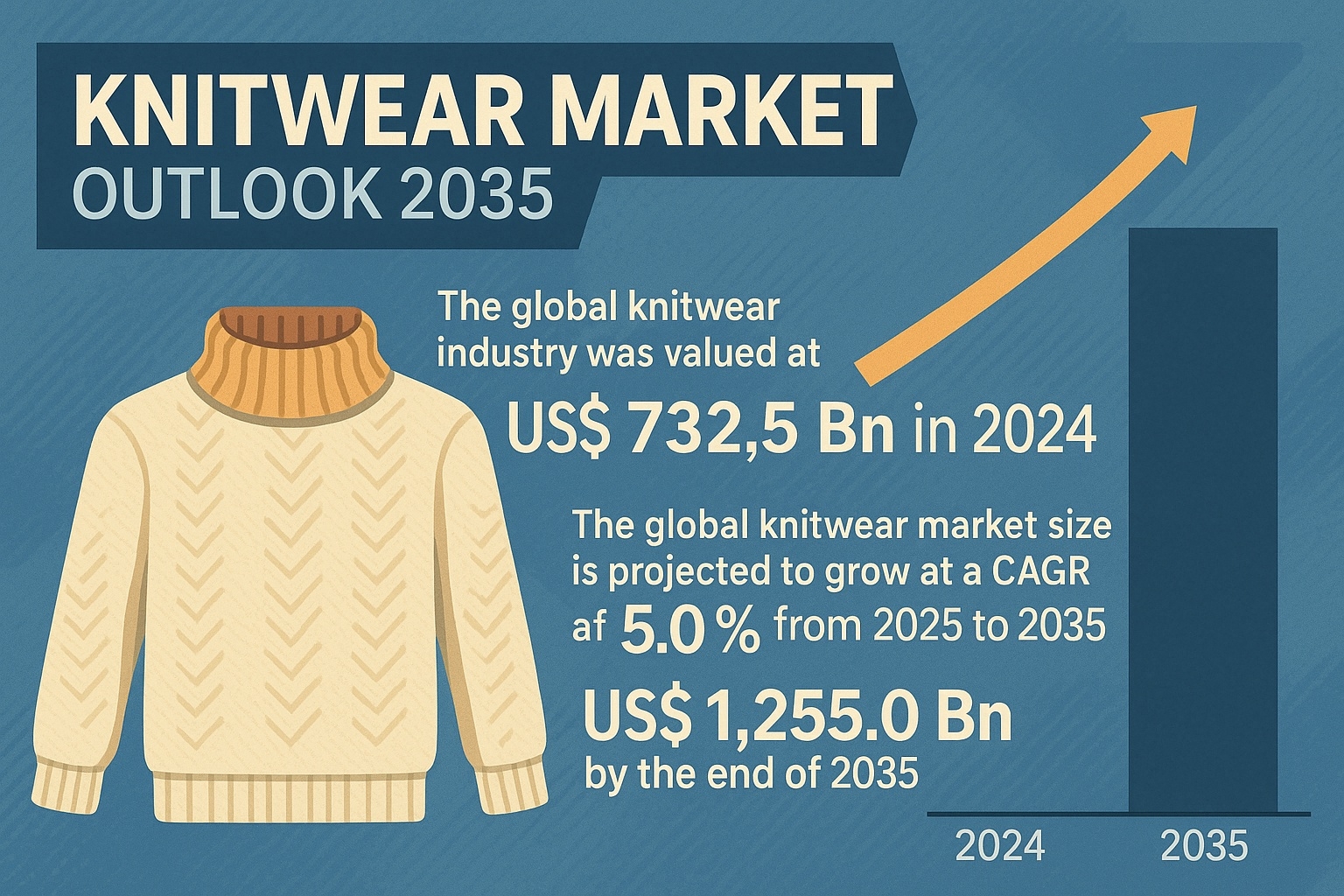Global Knitwear Market Weaves Ahead with Sustainability, Technology, and Fashion Synergy

The global knitwear market—valued at US$ 732.5 billion in 2024—is set to reach US$ 1,255.0 billion by 2035, growing at a CAGR of 5.0% between 2025 and 2035. This sustained growth is underpinned by evolving consumer lifestyles, rising fashion consciousness, and increasing demand for sustainable, high-performance apparel.
Knitwear’s enduring appeal lies in its unique combination of comfort, elasticity, and versatility—making it an essential part of wardrobes worldwide. From casualwear and innerwear to athleisure and luxury fashion, knitwear caters to a vast array of preferences, age groups, and climates, ensuring stable market expansion.
Key Market Drivers
1. Comfort and Performance in Everyday Fashion
Consumers today demand apparel that merges style, flexibility, and functionality. Knitwear meets this demand perfectly through stretchable, breathable, and lightweight fabrics that suit both daily wear and active lifestyles.
Technological advancements such as 3D knitting, seamless construction, and smart textiles have propelled the market toward innovation-driven growth. These technologies not only enhance product comfort and performance but also optimize resource use, contributing to a reduction in textile waste—a critical sustainability milestone.
The athleisure boom has significantly boosted knitwear’s global presence, as consumers opt for garments that balance comfort and trendiness. Sportswear brands and luxury fashion houses alike are leveraging technical knit fabrics to create multipurpose clothing suitable for fitness, travel, and leisure.
2. Sustainability: A Driving Force of Modern Fashion
Sustainability has become a core value in the global apparel landscape. Consumers are increasingly aware of the environmental footprint of fast fashion, leading to a surge in demand for eco-conscious knitwear.
Brands are responding with organic cotton, bamboo yarn, hemp fibers, and recycled polyester—materials that reduce carbon impact while maintaining quality. The adoption of circular fashion principles—including recycling programs, slow fashion models, and biodegradable textiles—is redefining how knitwear is produced and consumed.
This transformation not only aligns with environmental goals but also enhances brand credibility and consumer loyalty, positioning sustainable knitwear as both an ethical and economic opportunity for manufacturers.
Market Segmentation Insights
By Product Type
-
Innerwear dominates due to its consistent, non-seasonal demand and frequent replacement cycles.
-
Top wear (including sweaters, hoodies, and dresses) and bottom wear (leggings, trousers, and shorts) are driven by seasonal and fashion-based trends.
-
Accessories like caps, gloves, and socks continue to offer stable but niche growth.
By Material
-
Natural fibers (cotton, wool, cashmere) maintain premium appeal for their comfort and breathability.
-
Synthetic materials (polyester, acrylic, nylon) remain key for durability and affordability.
-
Blended fabrics are rapidly gaining traction, offering the optimal mix of performance and comfort.
By Knit Type
-
Weft knitted fabrics dominate casual and comfort wear.
-
Warp knitted fabrics are increasingly used in performance and technical apparel.
By Distribution Channel
The online retail segment is growing fastest, driven by the convenience of e-commerce and global reach of digital marketplaces. However, offline stores—especially specialty boutiques—retain importance for product experience and premium sales.
Regional Dynamics
Asia-Pacific: The Global Knitwear Powerhouse
The Asia-Pacific region leads the global knitwear market, driven by its cost-effective production, large population base, and rising consumer spending on fashion.
Countries like China, India, Japan, and South Korea not only manufacture for global brands but are also becoming major consumption centers, thanks to increasing urbanization, digital retail growth, and fashion-forward youth demographics.
Platforms such as Flipkart, Shopee, and Tmall have accelerated online knitwear sales across the region, democratizing access to global brands.
In contrast:
-
Europe remains a leader in luxury and sustainable knitwear, with focus on eco-friendly materials and high-end craftsmanship.
-
North America is characterized by strong demand for premium, seasonal, and lifestyle knitwear, particularly within the athleisure and designer categories.
Competitive Landscape
The global knitwear market is highly competitive and characterized by innovation, sustainability, and branding excellence. Prominent companies include:
Adidas AG, Nike Inc., H&M Group, Gap Inc., Fast Retailing (UNIQLO), Marks & Spencer Group, Ralph Lauren Corp., Lacoste, Loro Piana S.P.A., Gildan Activewear Inc., Victoria’s Secret, and Abercrombie & Fitch Co.
Strategic focus areas include:
-
Integration of eco-friendly materials and circular production systems.
-
Expansion into emerging markets via both physical and digital channels.
-
Collaboration with cultural influencers and designers to build brand resonance among Gen Z and Millennials.
-
Continuous investment in R&D for high-performance, lightweight, and innovative knitwear solutions.
Recent Strategic Developments
-
August 2025: H&M Group launched operations in Brazil, opening a flagship store in São Paulo and debuting its e-commerce platform hm.com.br, marking its entry into South America’s growing fashion market.
-
April 2025: Lacoste appointed Yujin An—leader of K-pop group IVE—as its new brand ambassador in Korea to strengthen its cultural relevance and youth engagement strategy in Asia.
Future Outlook
The coming decade will redefine knitwear through digital transformation, eco-innovation, and personalization. The integration of AI-driven design tools, 3D knitting automation, and biodegradable yarn technologies will reshape how brands create and consumers experience knitwear.
With the convergence of sustainability, technology, and style, the knitwear industry is positioned to lead the next phase of global apparel evolution—where comfort meets conscience, and fashion embraces functionality.
- Questions and Answers
- Opinion
- Motivational and Inspiring Story
- Technology
- Live and Let live
- Focus
- Geopolitics
- Military-Arms/Equipment
- Sécurité
- Economy
- Beasts of Nations
- Machine Tools-The “Mother Industry”
- Art
- Causes
- Crafts
- Dance
- Drinks
- Film/Movie
- Fitness
- Food
- Jeux
- Gardening
- Health
- Domicile
- Literature
- Music
- Networking
- Autre
- Party
- Religion
- Shopping
- Sports
- Theater
- Health and Wellness
- News
- Culture

